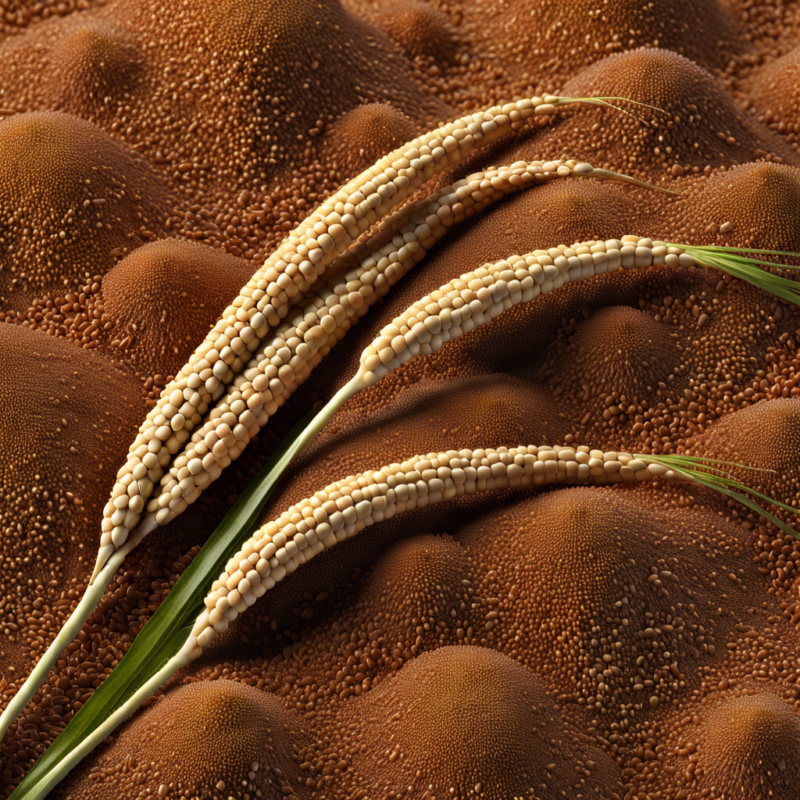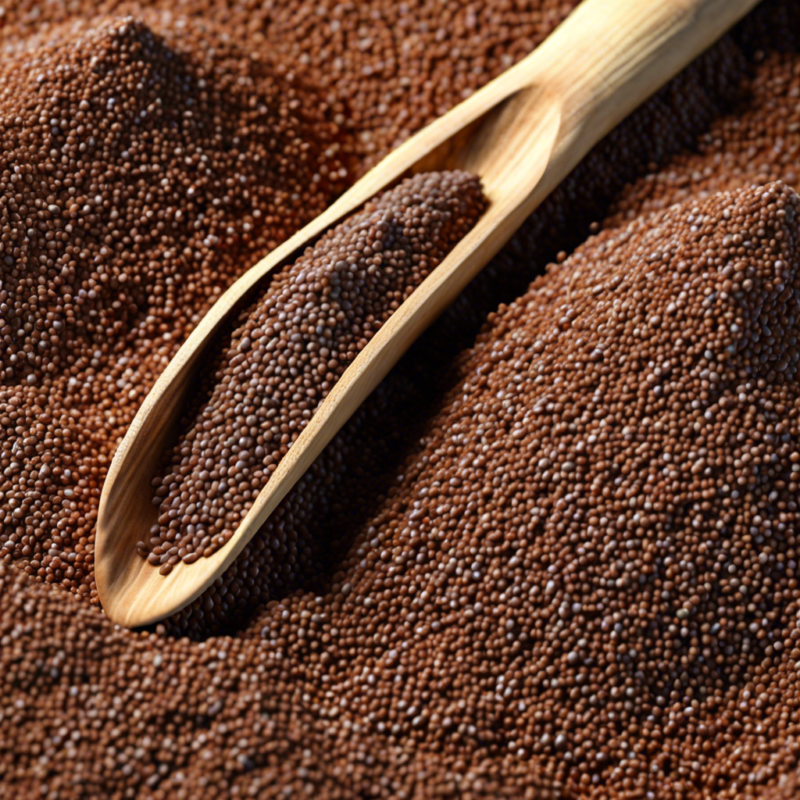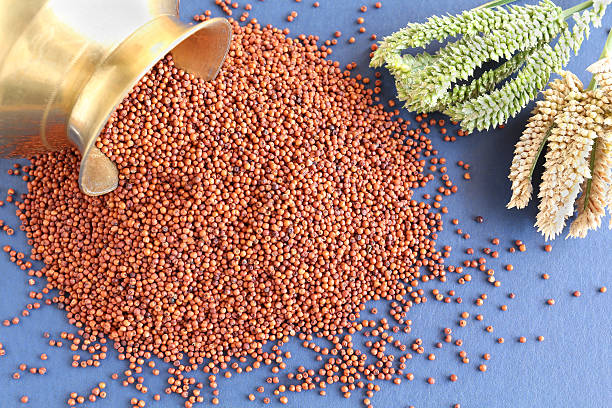Finger Millet ( Ragi )
Finger Millet: A Nutrient-Packed Ancient Grain
Finger millet, scientifically known as Eleusine coracana, is an ancient grain that has been cultivated for thousands of years. Also known as ragi in India, dagusa in Ethiopia, and kurakkan in Sri Lanka, this resilient crop thrives in arid and semi-arid regions. It is particularly valued for its high nutritional content and adaptability to diverse growing conditions. In this blog, we'll explore the history, cultivation, nutritional benefits, and culinary uses of finger millet, along with its impact on health and wellbeing.
Finger millet is a powerhouse of nutrition with a rich history and significant cultural importance. Its versatility in the kitchen, coupled with its numerous health benefits, makes it a valuable addition to modern diets. As awareness of its benefits grows, finger millet is gaining popularity not only in traditional growing regions but also in the global market.
Whether you are looking to manage your blood sugar levels, improve bone health, or simply add a nutritious and gluten-free grain to your diet, finger millet is a fantastic choice. As we continue to seek sustainable and nutritious food sources, this ancient grain stands out as a beacon of health and resilience.
Incorporating finger millet into your daily diet can be as simple as replacing regular flour with ragi flour in your favorite recipes or enjoying a warm bowl of millet porridge for breakfast. With its rich history, cultural significance, and exceptional nutritional profile, finger millet is truly a grain worth celebrating.

Health Benefits of Finger Millet
Improved Digestion:
- The high dietary fiber content in finger millet aids digestion by promoting regular bowel movements and preventing constipation. The insoluble fiber helps bulk up the stool, while the soluble fiber can aid in absorbing water and maintaining a smooth digestive process.
Rich in Natural Calcium:
- Finger millet's calcium content is particularly beneficial for individuals who are lactose intolerant or those who do not consume dairy products. It provides a plant-based source of calcium, which is crucial for maintaining bone density and preventing osteoporosis.
Anti-inflammatory Properties:
- The presence of phenolic compounds and flavonoids in finger millet contributes to its anti-inflammatory properties. These compounds help reduce inflammation in the body, which can lower the risk of chronic diseases such as arthritis and heart disease.
Boosts Skin Health:
- Finger millet contains amino acids such as methionine and lysine, which are essential for maintaining healthy skin. These amino acids help in collagen formation, which supports skin elasticity and prevents signs of aging.
Natural Relaxant:
- Finger millet contains natural relaxants like tryptophan, an amino acid that helps promote the release of serotonin in the brain. Serotonin is known to induce relaxation, alleviate stress, and improve mood, making finger millet beneficial for mental well-being.
Enhanced Immune System:
- The presence of essential nutrients like iron, zinc, and magnesium in finger millet helps strengthen the immune system. These nutrients are vital for the proper functioning of immune cells and the body's overall defense mechanisms.
Supports Lactation:
- In some cultures, finger millet is recommended for lactating mothers as it is believed to enhance milk production. The high nutritional content, especially calcium and iron, supports the health of both the mother and the breastfeeding baby.
Prevention of Gallstones:
- The insoluble fiber in finger millet may help reduce the risk of gallstone formation by reducing bile acid secretion. Bile acids are known to contribute to gallstone formation, so a diet high in insoluble fiber can be protective.
Reduction in Anemia Risk:
- In addition to being rich in iron, finger millet also contains vitamin C, which enhances iron absorption in the body. This makes it an effective food for preventing and managing anemia, particularly in populations where iron deficiency is prevalent.
Good for People with Celiac Disease:
- Since finger millet is naturally gluten-free, it is an excellent alternative for people with celiac disease or gluten intolerance. It allows them to enjoy a wide range of foods without compromising their health.
Supports Metabolism:
- The magnesium content in finger millet plays a critical role in metabolism. Magnesium is a co-factor in many enzymatic reactions in the body, including energy production, DNA synthesis, and muscle function.
Promotes Healthy Hair:
- The protein, iron, and essential amino acids in finger millet can contribute to healthy hair growth and prevent hair loss. Iron helps in delivering oxygen to hair follicles, promoting hair growth, while amino acids support keratin production, which strengthens hair strands.
Hormonal Balance:
- The lignans in finger millet can mimic estrogen-like effects, which may help balance hormone levels, particularly in post-menopausal women. This can aid in reducing symptoms such as hot flashes and osteoporosis.
Detoxification:
- Finger millet is known for its ability to detoxify the body. The dietary fiber helps in flushing out toxins from the digestive system, and the antioxidants help neutralize free radicals, which can damage cells and tissues.
Enhances Athletic Performance:
- The complex carbohydrates in finger millet provide a slow and steady release of glucose into the bloodstream, making it an excellent source of energy for athletes. The presence of essential amino acids also helps in muscle repair and recovery.

Historical Background and Discovery
Finger millet's origins can be traced back to the highlands of East Africa, particularly Ethiopia and Uganda, where it has been cultivated for over 5,000 years. It spread to India around 3000 BC, where it became a staple crop, particularly in the southern and western regions. The grain's ability to withstand harsh climates and poor soils made it an essential food source in these regions, especially during periods of drought.
The name "finger millet" is derived from the finger-like shape of its seed head, which can contain hundreds of tiny grains. These grains are hardy and can be stored for several years without spoiling, making finger millet a reliable food source in areas with limited food security.
Nutritional Profile and Health Benefits
Finger millet is often celebrated for its exceptional nutritional profile. It is a rich source of essential nutrients, making it a valuable addition to the diet. Here are some of the key nutritional components and health benefits associated with finger millet:
High Calcium Content: Finger millet is one of the richest plant sources of calcium, providing about 350 mg per 100 grams of grains. This makes it particularly beneficial for bone health, especially for children, pregnant women, and the elderly.
Dietary Fiber: It is an excellent source of dietary fiber, which aids in digestion and helps maintain healthy bowel movements. The fiber content also contributes to a feeling of fullness, which can help in weight management.
Protein: While not as high in protein as some other grains, finger millet contains significant amounts of essential amino acids, including methionine, which is often lacking in the diets of those dependent on cereals.
Antioxidants: The grain is rich in antioxidants, particularly polyphenols, which help in combating oxidative stress and reducing the risk of chronic diseases such as cancer and cardiovascular diseases.
Low Glycemic Index: Finger millet has a low glycemic index, making it an ideal food for diabetics. It helps in maintaining steady blood sugar levels and provides sustained energy release.
Iron and Other Micronutrients: It is a good source of iron, magnesium, and other essential minerals, contributing to overall health and wellbeing.
Gluten-Free: As a gluten-free grain, finger millet is an excellent dietary option for those with gluten intolerance or celiac disease.
Cultivation and Global Distribution
Finger millet is predominantly grown in India and Africa, where it is a staple food for millions of people. India is the largest producer, with major cultivation areas in the states of Karnataka, Tamil Nadu, Andhra Pradesh, Maharashtra, and Odisha. In Africa, countries like Uganda, Ethiopia, and Kenya are major producers.
The crop's resilience to adverse environmental conditions, such as drought and poor soil fertility, makes it an invaluable resource in regions prone to food insecurity. Finger millet can be grown in areas with minimal rainfall, and it requires less water compared to other cereals like rice and wheat. This drought-resistant nature is particularly beneficial in the face of climate change and erratic weather patterns.
Culinary Uses and Cultural Significance
Finger millet is versatile in the kitchen and can be used in various culinary preparations. In India, it is often ground into flour to make traditional foods like ragi roti (flatbread), ragi mudde (a soft dough-like dish), and ragi dosa (a type of pancake). In Africa, it is commonly used to make porridge or fermented beverages. Finger millet can also be used as a nutritious ingredient in baking, added to bread, cakes, and cookies.
Beyond its nutritional value, finger millet holds cultural significance in many communities. In parts of India, it is used in rituals and festivals, symbolizing prosperity and health. Its long history and continued importance in traditional diets underscore its cultural and nutritional relevance.


